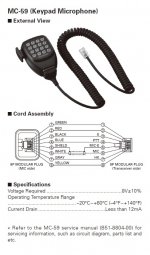First post from an amateur radio newbie:
I have mounted my 710G behind my second row seats. I need a mic extension cable that can run to the driver's side doors and under their sill plates up to under the dash and finally come out above my info screen. This will be about 15-20 ft. I know that the Kenwood's mic has a crazy pinout. If I were to use a standard CAT5e/6/6a/7/8 cable, the mic line and the DTMF's GND would be shared and would result in the 10Hz "woodpecker" sound. I thought I'd be smart and make my own cable. I got a 25' long CAT8 cable, RJ45 crimping tool, and CAT6 shielded RJ45 jacks. I used the CAT8 cable because each pair of wires is individually foil wrapped. I trimmed the ends off and crimped the RJ45 with the following pinout:
I have mounted my 710G behind my second row seats. I need a mic extension cable that can run to the driver's side doors and under their sill plates up to under the dash and finally come out above my info screen. This will be about 15-20 ft. I know that the Kenwood's mic has a crazy pinout. If I were to use a standard CAT5e/6/6a/7/8 cable, the mic line and the DTMF's GND would be shared and would result in the 10Hz "woodpecker" sound. I thought I'd be smart and make my own cable. I got a 25' long CAT8 cable, RJ45 crimping tool, and CAT6 shielded RJ45 jacks. I used the CAT8 cable because each pair of wires is individually foil wrapped. I trimmed the ends off and crimped the RJ45 with the following pinout:
- BLUE (foil pair 1)
- BLUE WHITE (foil pair 1)
- BROWN (foil pair 2)
- BROWN WHITE (foil pair 2)
- GREEN (foil pair 3)
- GREEN WHITE (foil pair 3)
- ORANGE (foil pair 4)
- ORANGE WHITE (foil pair 4)


